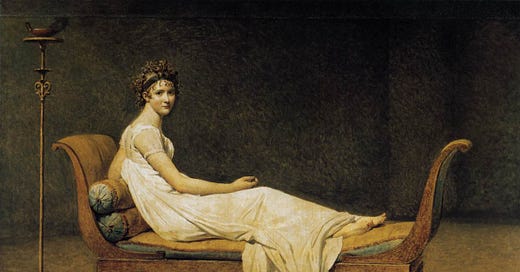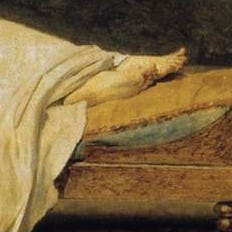What a 200-Year-Old Painting Taught Me About Storytelling
A single detail in a Jacques‑Louis David portrait changed how I write and see stories forever
I was 16 when I first saw the portrait of Madame Recamier, painted by Jacques-Louis David in 1800.
The portrait of the prominent French socialite was projected in one of my first art history lessons in a small classroom that smelt of acrylic paints and old books.
At a glance, the portrait was elegant, composed, serene. I was mesmerised.
“What is the story here? who can tell me?”
Mrs. L, our art history teacher, was a petite woman with a large head – both physically and figuratively.
Everyone was an idiot according to her.
She was always in loose blouses and palazzo trousers, everything was in layers of black or forest green and paired with statement necklace pieces made of beads and stones in maroons or red.
Her arms flailed wildly as she insisted, often in frustration, that if we just learned how to read art, that we could read the whole world and become better people.
Mrs. L was also a racist. I’m not sure how that fits into her philosophy about art and humanity but that’s a story for another time.
When no one answered her question, Mrs. L rolled her eyes and explained the “obvious” details of the painting, details I’ve come to deeply appreciate, revisit, and elaborate on over the years.
Madame Recamier reclines, not with indulgence but with restraint, draped in a translucent, empire-waisted gown, her body resting against a curving Directoire-style sofa.
Her posture is angled away, her head turns toward us but her gaze floats, dazed and distant.
She’s detached, contemplative, unaffected.
The background is bare. There is no velvet drapery, no ornate furniture to anchor her in time or place. She wears no jewellery. No ornaments to distract us.
“I’ve told you what’s in the painting. Now tell me what the painting is about. What is happening here?”
Silence. We were too scared to speak.
What was left to say? It was a beautiful, hypnotic painting. That was it.
“We’re all going to stare at this painting and no one is leaving until someone answers. I don’t care if the bell rings.”
I didn’t know how to articulate what struck me. There was a simplicity, something unfinished, a moment that felt like it was behind the scenes.
“Look at her feet…”
Mrs. L seethed, after a moment that seemed to drag.
Madame Recamier’s feet were bare. Unshod, pale, and softly placed. So entranced by her face and the background that I hadn’t noticed.
Before anyone gets too excited this isn’t a story about feet pics, foot fetishes or the like. Madame Recamier’s feet aren’t on Wikifeet. Well, they might be, I wouldn’t know as I haven’t checked and don’t plan on checking either.
The detail of her bare feet, I learned, was unusual for the time, defying the conventions of portraiture. In an era when shoes signified class and propriety, Madame Recamier’s bare feet could be read as symbolic or even scandalous.
It could suggest purity, a nod to the antique statues David admired. Or perhaps an indication of intimacy.
“Why would you be laying somewhere with your bare feet? You’re waiting for someone, aren’t you?”
Mrs. L’s words were followed a ripple of giggles.
“Oh, grow up,” she snapped.
This small detail disrupted everything I knew about storytelling.
Why would a woman of status, painted by one of the most prominent artists of the era, be shown without shoes?
It wasn’t an oversight. It was deliberate. A symbol of neoclassical ideals, yes, but also a quiet rebellion against aristocratic formality.
Suddenly, the entire painting opened up and so did my understanding of storytelling.
That detail sent me down a rabbit hole, not just of art history, but of narrative thinking.
I imagined hundreds of scenarios and stories. Who was Madame Recamier waiting for? Why were they coming? What did it mean?
Then I thought about the most important question of all. The question I always ask myself when I come across an interesting fact, detail or idea… how would I write this story?
How would I reveal the detail of Madame Recamier’s bare feet in an essay? What did it mean? What did it say about the era? How could I write about it in a way to make it as interesting as I found it?
In any form of storytelling whether journalism, fiction, communication, the smallest details carry the most meaning.
A gesture. A word. A pause in a quote. These are the moments that move a piece from competent to compelling.
Ever since that class, I’ve looked for the details in artworks, in texts, to solve the puzzle of what something small might be saying about something much larger.
And when it comes to weaving narratives, no matter the medium, Madame Recamier taught me that great storytelling isn't just about the big themes.
It’s about texture, nuance, specificity.
The details and where they are placed matter just as much as the story itself.







Felt I was in this class with you Maan!